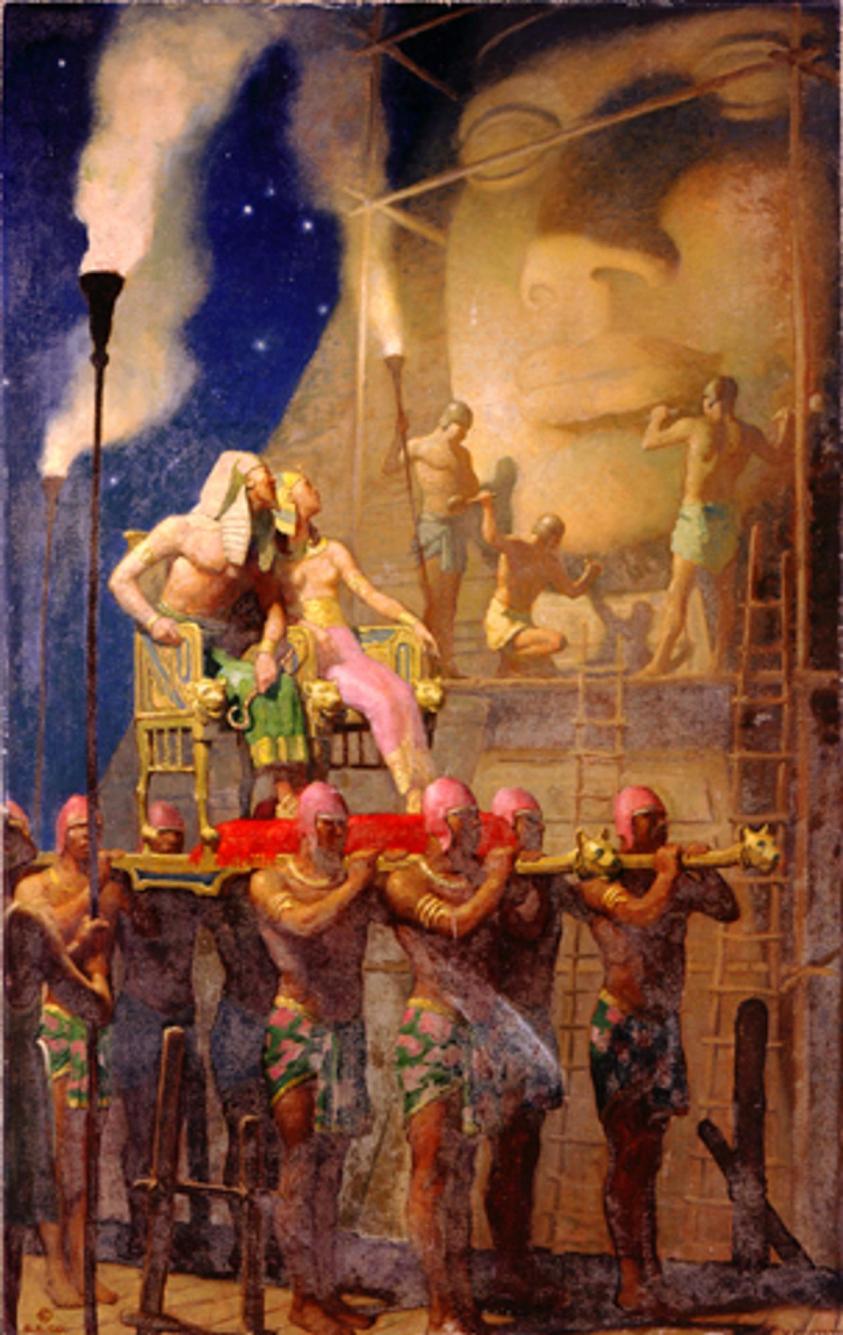Artist:
N.C. Wyeth
(American, 1882 - 1945)
The Carvers of the Sphinx
Medium: Oil on canvas adhered to hardboard
Date: 1926
Dimensions:
36 1/8 × 23 in. (91.8 × 58.4 cm)
American Illustrators Gallery, New York, NY
Accession number: SUPP2000.1392
Research Number: NCW: 1392
InscribedLower right: N. C. WYETH; lower left: © / G. E. CO.; adhered to front of frame, a 1 1/4 x 9 9/16" piece of canvas from original design, text block with letters: The CARVERS of the SPHINX
Provenance(Christie's, New York, NY, May 18, 2004, lot. no. 152); (American Illustrators Gallery, New York, NY, 2005)
References
"Sketch Club Members at N. C. Wyeth Studio," (unidentified Wilmington, DE, newspaper clipping), Sept. 14, 1926, p. ; Betsy James Wyeth, ed., The Wyeths, The Letters of N. C. Wyeth, 1901-1945 (Boston: Gambit, 1971), p. 727; Douglas Allen and Douglas Allen, Jr., N. C. Wyeth, The Collected Paintings, Illustrations and Murals (New York: Crown Publishers, 1972), p. 152, calendar illustration in color p. 147; Christine B. Podmaniczky, N. C. Wyeth, A Catalogue Raisonné of Paintings (London: Scala, 2008), C.60, p. 657
Curatorial RemarksIn September, 1926, the artist wrote: "I have just put the finishing touches upon a piece of work for the Forbes Company (a calendar to be used by the Edison Mazda Company.) It is an elaborate piece of work and has taken a solid month to do . It will be called "The Carvers of the Sphinx"--a night scene: torchlight revealing King Chedren and his spouse searted in their golden double chair, supported on the shoulders of 8 eunuchs, watching the carvers at work on the huge stone face. It is very closely done and is exceedingly dramatic. The border and other design around the picture is very elaborate and all Egyptian in motive. I have an idea that the picture will make quite a hit. They are to pay me $3500, which is nice to think about now that it is done." (Betsy James Wyeth, p. 727). A complete calendar for year 1935 carries the legend in the lower left: © / G.E. Co. / 1934 (Schoonover Collection, Delaware Art Museum).
Among the proofs of illustration and tear sheets found in the artist's studio is a black and white proof of an early concept of this design (Brandywine River Museum library collection, no. 4317). The figures are only blocked in and the surrounding decoration is far less elaborate than that Wyeth described in his letter or that which adorns the reproduction. Although the painting came to light in 2004 without the surrounding decoration, a piece of the painted decoration was glued to the frame confirming that the decorative work seen on the calendar was part of the original canvas. Correspondence regarding a companion piece (NCW 1160, The Torch Race) suggests both canvases were trimmed and applied to hardboard backings after the artist's death (Leslie R. Mansfield to Anne E. Mayer, Oct. 19, 1972, Brandywine River Museum).;The Wilmington Sketch Club visited the artist's studio in September, 1926, and an article in a local newspaper documenting the trip reports that the group saw the painting in the studio at that time ("Sketch Club Members at N. C. Wyeth Studio," unidentified Wilmington newspaper, Sept. 14, 1926, p. ). "The prime attraction also was the art calendar he is preparing for the Edison Lamp Co., an exquisite Egyptian torch-illumination scene."
Among the proofs of illustration and tear sheets found in the artist's studio is a black and white proof of an early concept of this design (Brandywine River Museum library collection, no. 4317). The figures are only blocked in and the surrounding decoration is far less elaborate than that Wyeth described in his letter or that which adorns the reproduction. Although the painting came to light in 2004 without the surrounding decoration, a piece of the painted decoration was glued to the frame confirming that the decorative work seen on the calendar was part of the original canvas. Correspondence regarding a companion piece (NCW 1160, The Torch Race) suggests both canvases were trimmed and applied to hardboard backings after the artist's death (Leslie R. Mansfield to Anne E. Mayer, Oct. 19, 1972, Brandywine River Museum).;The Wilmington Sketch Club visited the artist's studio in September, 1926, and an article in a local newspaper documenting the trip reports that the group saw the painting in the studio at that time ("Sketch Club Members at N. C. Wyeth Studio," unidentified Wilmington newspaper, Sept. 14, 1926, p. ). "The prime attraction also was the art calendar he is preparing for the Edison Lamp Co., an exquisite Egyptian torch-illumination scene."
Image Source for printed Catalogue Raisonne:Transparency directly from painting
Photo Credit:Courtesy of Christie's, New York, NY


